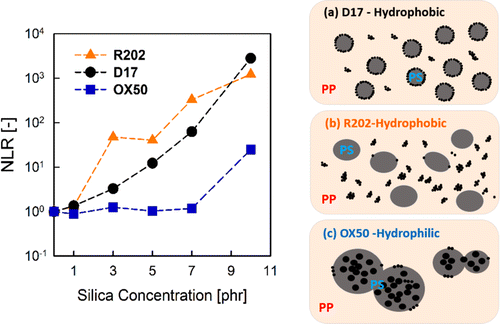当前位置:
X-MOL 学术
›
Macromolecules
›
论文详情
Our official English website, www.x-mol.net, welcomes your
feedback! (Note: you will need to create a separate account there.)
Characterization of Effects of Silica Nanoparticles on (80/20) PP/PS Blends via Nonlinear Rheological Properties from Fourier Transform Rheology
Macromolecules ( IF 5.1 ) Pub Date : 2015-06-25 00:00:00 , DOI: 10.1021/acs.macromol.5b00679 Reza Salehiyan 1 , Hyeong Yong Song 1 , Woo Jin Choi 2 , Kyu Hyun 1
Macromolecules ( IF 5.1 ) Pub Date : 2015-06-25 00:00:00 , DOI: 10.1021/acs.macromol.5b00679 Reza Salehiyan 1 , Hyeong Yong Song 1 , Woo Jin Choi 2 , Kyu Hyun 1
Affiliation

|
Effects of silica nanoparticles with different natures (hydrophilicity and hydrophobicity) on (80/20) PP/PS blends were investigated via linear and nonlinear rheological properties. The hydrophilic silica nanoparticle was fumed silica OX50 while the two hydrophobic ones were precipitated silica D17 and fumed silica R202. SEM images revealed that hydrophilic OX50 could not improve morphological properties of the blends. On the other hand, the two hydrophobic silica nanoparticles (R202 and D17) improved morphological properties. TEM examination showed that OX50 silica nanoparticles aggregated inside PS droplets, thereby making breakup of PS (dispersed) phase into smaller sizes more difficult. D17 and R202 improved morphological properties regardless of the different droplet size reduction mechanisms, and rheological properties improved as a result. Both linear rheological properties from SAOS (small-amplitude oscillatory shear) tests and nonlinear rheological properties from LAOS (large-amplitude oscillatory shear) tests were obtained. The nonlinear–linear viscoelastic ratio (NLR ≡ normalized nonlinear rheological properties/normalized linear rheological properties) was used to quantify the degree of droplet dispersion and distinguish the effects of silica particles on the morphology of PP/PS blends. Previous research has observed an inverse correlation between NLR and droplet size. PP/PS/OX50 blends with no alteration of droplet size showed constant NLR values (≅1) with increasing concentration of OX50 (hydrophilic silica). However, NLR values of PP/PS blends with hydrophobic silica nanoparticles (D17 and R202) were much larger than 1 (NLR > 1) and increased with silica concentration, which is consistent with morphological evolution, i.e., reducing droplet size. However, NLR values of PP/PS/R202 blends were relatively larger than those of PP/PS/D17 blends despite smaller droplet sizes. This can be attributed to a different morphology microstructure, i.e., R202 located in PP matrix phase and D17 at interface between PP and PS. Therefore, the NLR value of PP/PS/silica blend could be due to the combined effects of the interface between droplets (PP/PS blend) and particle–polymer interactions (PP/silica nanocomposites). Especially, R202 showed larger NLR values due to PP/R202 nanocomposites. Based on these findings, relative NLR (= NLRPP/PS/silica/NLRPP/silica) is proposed as an effective measurement of droplet size information in PP/PS blends by eliminating the effects of PP/silica nanocomposites. Relative NLR matched well with droplet size evolution from the SEM results.
中文翻译:

二氧化硅纳米颗粒对(80/20)PP / PS共混物的影响,通过傅里叶变换流变学的非线性流变特性进行表征
通过线性和非线性流变特性研究了具有不同性质(亲水性和疏水性)的二氧化硅纳米粒子对(80/20)PP / PS共混物的影响。亲水性二氧化硅纳米粒子是气相二氧化硅OX50,而两个疏水性粒子是沉淀二氧化硅D17和气相二氧化硅R202。SEM图像表明,亲水性OX50不能改善共混物的形态学性能。另一方面,两个疏水性二氧化硅纳米颗粒(R202和D17)改善了形态学性能。TEM检查表明,OX50二氧化硅纳米颗粒聚集在PS小滴内,从而使PS(分散)相破碎成较小尺寸的困难更大。D17和R202改善了形态学特性,而与减小液滴尺寸的机制无关,结果改善了流变特性。获得了来自SAOS(小振幅振荡剪切)测试的线性流变特性和来自LAOS(大振幅振荡剪切)测试的非线性流变特性。非线性-线性粘弹性比(NLR≡归一化非线性流变特性/归一化线性流变特性)用于量化液滴的分散程度,并区分二氧化硅颗粒对PP / PS共混物形态的影响。先前的研究已经观察到NLR与液滴尺寸之间呈负相关。不会改变液滴尺寸的PP / PS / OX50共混物显示出恒定的NLR值(≅1),随OX50(亲水性二氧化硅)浓度的增加而增加。但是,PP / PS与疏水性二氧化硅纳米粒子(D17和R202)共混物的NLR值远大于1(NLR> 1),并且随二氧化硅浓度的增加而增加,这与形态演变,即减小液滴尺寸是一致的。然而,尽管液滴尺寸较小,PP / PS / R202混合物的NLR值仍比PP / PS / D17混合物的NLR值相对较大。这可以归因于不同的形态微观结构,即位于PP基质相中的R202和位于PP与PS之间的界面的D17。因此,PP / PS /二氧化硅混合物的NLR值可能是由于液滴之间的界面(PP / PS混合物)和颗粒-聚合物相互作用(PP /二氧化硅纳米复合物)的综合作用所致。特别地,由于PP / R202纳米复合材料,R202显示出较大的NLR值。根据这些发现,相对NLR(= NLR 尽管液滴尺寸较小,但PP / PS / R202共混物的NLR值相对大于PP / PS / D17共混物的NLR值。这可以归因于不同的形态微观结构,即位于PP基质相中的R202和位于PP与PS之间的界面的D17。因此,PP / PS /二氧化硅混合物的NLR值可能是由于液滴之间的界面(PP / PS混合物)和颗粒-聚合物相互作用(PP /二氧化硅纳米复合物)的综合作用所致。特别地,由于PP / R202纳米复合材料,R202显示出较大的NLR值。根据这些发现,相对NLR(= NLR 尽管液滴尺寸较小,但PP / PS / R202共混物的NLR值相对大于PP / PS / D17共混物的NLR值。这可以归因于不同的形态微观结构,即位于PP基质相中的R202和位于PP与PS之间的界面的D17。因此,PP / PS /二氧化硅混合物的NLR值可能是由于液滴之间的界面(PP / PS混合物)和颗粒-聚合物相互作用(PP /二氧化硅纳米复合物)的综合作用所致。特别地,由于PP / R202纳米复合材料,R202显示出较大的NLR值。根据这些发现,相对NLR(= NLR PP / PS /二氧化硅混合物的NLR值可能是由于液滴之间的界面(PP / PS混合物)和颗粒-聚合物相互作用(PP /二氧化硅纳米复合物)的综合作用所致。特别地,由于PP / R202纳米复合材料,R202显示出较大的NLR值。根据这些发现,相对NLR(= NLR PP / PS /二氧化硅混合物的NLR值可能是由于液滴之间的界面(PP / PS混合物)和颗粒-聚合物相互作用(PP /二氧化硅纳米复合物)的综合作用所致。特别地,由于PP / R202纳米复合材料,R202显示出较大的NLR值。根据这些发现,相对NLR(= NLR通过消除PP /二氧化硅纳米复合材料的影响,提出了PP / PS /二氧化硅/ NLR PP /二氧化硅作为PP / PS共混物中液滴尺寸信息的有效测量方法。相对NLR与从SEM结果得出的液滴尺寸变化非常吻合。
更新日期:2015-06-25
中文翻译:

二氧化硅纳米颗粒对(80/20)PP / PS共混物的影响,通过傅里叶变换流变学的非线性流变特性进行表征
通过线性和非线性流变特性研究了具有不同性质(亲水性和疏水性)的二氧化硅纳米粒子对(80/20)PP / PS共混物的影响。亲水性二氧化硅纳米粒子是气相二氧化硅OX50,而两个疏水性粒子是沉淀二氧化硅D17和气相二氧化硅R202。SEM图像表明,亲水性OX50不能改善共混物的形态学性能。另一方面,两个疏水性二氧化硅纳米颗粒(R202和D17)改善了形态学性能。TEM检查表明,OX50二氧化硅纳米颗粒聚集在PS小滴内,从而使PS(分散)相破碎成较小尺寸的困难更大。D17和R202改善了形态学特性,而与减小液滴尺寸的机制无关,结果改善了流变特性。获得了来自SAOS(小振幅振荡剪切)测试的线性流变特性和来自LAOS(大振幅振荡剪切)测试的非线性流变特性。非线性-线性粘弹性比(NLR≡归一化非线性流变特性/归一化线性流变特性)用于量化液滴的分散程度,并区分二氧化硅颗粒对PP / PS共混物形态的影响。先前的研究已经观察到NLR与液滴尺寸之间呈负相关。不会改变液滴尺寸的PP / PS / OX50共混物显示出恒定的NLR值(≅1),随OX50(亲水性二氧化硅)浓度的增加而增加。但是,PP / PS与疏水性二氧化硅纳米粒子(D17和R202)共混物的NLR值远大于1(NLR> 1),并且随二氧化硅浓度的增加而增加,这与形态演变,即减小液滴尺寸是一致的。然而,尽管液滴尺寸较小,PP / PS / R202混合物的NLR值仍比PP / PS / D17混合物的NLR值相对较大。这可以归因于不同的形态微观结构,即位于PP基质相中的R202和位于PP与PS之间的界面的D17。因此,PP / PS /二氧化硅混合物的NLR值可能是由于液滴之间的界面(PP / PS混合物)和颗粒-聚合物相互作用(PP /二氧化硅纳米复合物)的综合作用所致。特别地,由于PP / R202纳米复合材料,R202显示出较大的NLR值。根据这些发现,相对NLR(= NLR 尽管液滴尺寸较小,但PP / PS / R202共混物的NLR值相对大于PP / PS / D17共混物的NLR值。这可以归因于不同的形态微观结构,即位于PP基质相中的R202和位于PP与PS之间的界面的D17。因此,PP / PS /二氧化硅混合物的NLR值可能是由于液滴之间的界面(PP / PS混合物)和颗粒-聚合物相互作用(PP /二氧化硅纳米复合物)的综合作用所致。特别地,由于PP / R202纳米复合材料,R202显示出较大的NLR值。根据这些发现,相对NLR(= NLR 尽管液滴尺寸较小,但PP / PS / R202共混物的NLR值相对大于PP / PS / D17共混物的NLR值。这可以归因于不同的形态微观结构,即位于PP基质相中的R202和位于PP与PS之间的界面的D17。因此,PP / PS /二氧化硅混合物的NLR值可能是由于液滴之间的界面(PP / PS混合物)和颗粒-聚合物相互作用(PP /二氧化硅纳米复合物)的综合作用所致。特别地,由于PP / R202纳米复合材料,R202显示出较大的NLR值。根据这些发现,相对NLR(= NLR PP / PS /二氧化硅混合物的NLR值可能是由于液滴之间的界面(PP / PS混合物)和颗粒-聚合物相互作用(PP /二氧化硅纳米复合物)的综合作用所致。特别地,由于PP / R202纳米复合材料,R202显示出较大的NLR值。根据这些发现,相对NLR(= NLR PP / PS /二氧化硅混合物的NLR值可能是由于液滴之间的界面(PP / PS混合物)和颗粒-聚合物相互作用(PP /二氧化硅纳米复合物)的综合作用所致。特别地,由于PP / R202纳米复合材料,R202显示出较大的NLR值。根据这些发现,相对NLR(= NLR通过消除PP /二氧化硅纳米复合材料的影响,提出了PP / PS /二氧化硅/ NLR PP /二氧化硅作为PP / PS共混物中液滴尺寸信息的有效测量方法。相对NLR与从SEM结果得出的液滴尺寸变化非常吻合。




















































 京公网安备 11010802027423号
京公网安备 11010802027423号